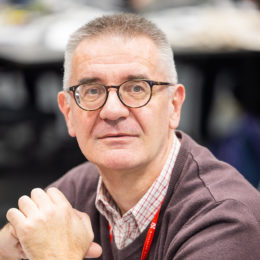Modern wars differ from the classic ones in that they use not only military equipment and regular troops. Values, ideology, culture, symbols, media, humor are becoming weapons in the 21st century.
Orest Semotiuk
Russia’s aggression against Ukraine, which began in 2014 with the annexation of Crimea and the occupation of Donbass, has been evaluated as a “hybrid war”. After the full-scale invasion of Russia on February 24, 2022, Ukraine not only became a theater of hostilities in Europe, but also a topic №1 in the world media. Political humor in Ukraine and worldwide became a weapon. The heroic resistance of Ukrainians and Russia’s war crimes against civilians have been reflected in political humor both in Ukraine and around the world. Accordingly, the project aims to analyze the implementation and evolution of the discursive dimension of the Ukrainian-Russian War in cartoons and memes. To achieve this goal we are going to analyze concepts „political humor“, „political satire“,“political cartoon”, to describe their main types, to analyze how the Russian-Ukrainian War is reflected in cartoons an memes as forms of political humor.
Until now, research on political humor in Ukraine has been fragmentary, focusing primarily on a theoretical description of existing post-Soviet approaches on humor in Ukrainian political discourse and on framing of Ukrainian politics and politicians in political sketches. We are going to investigate similarities and differences in conflict depiction („self image” and “external image” of the conflict course, conflict participants, conflict consequences) in Ukrainian and World political cartoons and memes. Special attention is paid to a) rapid growth of global interest in Ukraine, opposing the aggressor; b) gradual changes in the attitude of world leaders to the Russian-Ukrainian war, due to public pressure and diplomatic efforts of Ukraine; с) Putin’s transformation into a global pariah; d) the evolution of President Zelensky’s attitude to ways to resolve the conflict before and after 24.02.
Since 2014, political cartoons have been in the focus of my research. Previous publications have explored the theoretical aspects of political cartoon: typology, functions, and interpretations. (Semotyuk 2014, Semotyuk 2015). Later we attempted to apply the computer based content analysis to our research. After Russian aggression in Ukraine, political cartoons covering the Russian-Ukrainian military conflict were analyzed (Semotyuk 2019, Semotyuk 2020), and a monograph summarizing the results of the study was prepared and published. (Semotyuk 2021). With the election of Zelensky as President of Ukraine, not only political cartoons but also memes as a unit of the humorous media political discourse became a subject of my research. Based on preliminary research results (using computer content analysis) in 2020 and early 2021, one article was published describing the discursive understanding of the president’s domestic and foreign policies. (Semotyuk 2021). After February 24, 2022, I decided to continue the analysis of the discursive dimension of the Russian-Ukrainian military conflict and to expand the research corpus. The corpus consists of ca.3000 political cartoons and memes from 33 countries from all parts of the World. The study period spans 36 months, from May 2019 to June 2022. The social context of the study is shaped by the course of events related to the Russian-Ukrainian military conflict before and after 24.02.22 and Zelensky’s activities as the Supreme Commander-in-Chief of the Ukrainian Army. The research material comes from Ukrainian and international freely accessible sources: social media and web-galleries. The project integrates national and international (global) levels of political humorous discourse and proposes a contrastive analysis of the discursive dimension of the Russian-Ukrainian war and its implementation in political humor. The project is based on significant correlation of the real and discursive dimension of the conflict (international military-political assistance to Ukraine and the reflection of this support in the national and international political humor). The implementation of the project will:
a) expand the research area of Slavic Studies by intercultural aspects;
b) enrich the methodological toolset of Media Linguistics;
c) bring in the scientific use modern approaches, which are partially unknown among Ukrainian researchers.
This project will explain how Media Linguistics can be related to other disciplines (social anthropology, discourse and humor studies, political communication) and identify the added value that it brings to these disciplines. Project results will be disseminated on international conferences, in research papers for peer-reviewed journals, on the website as well via special Facebook page and Telegram or Instagram channel with project updates.
Project details
Project title: Laughter during the war: Russian aggression in Ukraine in political cartoons and memes
Principal Investigator: dr Orest Semotiuk
Host institution: Institute of Slavic Studies, Polish Academy of Sciences
Project duration: 01.04.2023 – 31.03.2025
Project’s website: https://humoresearch.ispan.edu.pl/

